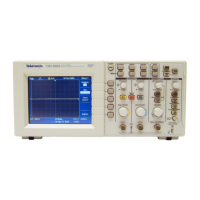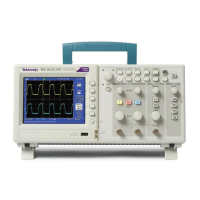Theory of Operation
TDS1000B and TDS2000B Series Oscilloscope Service Manual
3-- 5
The processing and display system consists of the display ASIC, DRAM, and
system oscillator. Digitized acquisition samples are received by the display ASIC
and stored in DRAM. Once data are received by the display ASIC, various
corrections are applied, display rasterization is performed, and the waveform is
placed into a display buffer. At the same time, the waveform is being read from
the display buffers and written to the LCD. Additional circuitry in the display
ASIC supports scanning the front panel, handling DRAM refresh, providing the
processor clock, and performing various memory mapping tasks required by all
elementary microprocessor based systems. In a four-channel system, the two
display ASICs are interconnected so that one ASIC may provide display
information for the second.
The processing and display system handles some of the computational tasks.
Other tasks are performed by the processor system. Since all array processing is
performed in the processing and display system, no computations can be
performed that involve data from two different channel sets. Thus, subtracting
channel 3 data from channel 2 is prohibited. Channel 1 and Channel 2 data may
be combined in all of the supported ways.
BNC connectors are mounted on the main board for all signal inputs. The signal
inputs are compatible with the supplied P2220 probes.
The PROBE COMP and ground terminals are provided for probe adjustment.
The EXT TRIG channel is processed on the chain containing the highest
numbered normal input channel.
To support various functions on the main board, a number of secondary power
supplies are generated. For the amplifier and acquisition ASICs, the main board
creates a +2.5 V and --2.5 V supply. The +2.5 V supply is derived from the
+3.3 V logic supply. The --2.5 V supply is derived from the --4 V supply. One
three terminal regulator provides +5 V for internal uses. A second three terminal
regulator provides USB power to preclude USB faults from seriously disrupting
operation of the oscilloscope.
An additional power supply provides the LCD bias voltage which ranges from
+19 V to +28 V, depending on contrast setting and display type. This +28 V
supply has a temperature sensor on the front-panel board that varies the output
voltage of the supply to maintain contrast over a wide temperature range.
Processing and Display
System
Input Signal Interface
Probe Compensation
External Trigger
Main Board Power

